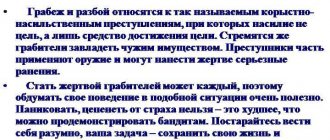Murder for profit or for hire has one goal - enrichment. It doesn’t matter how - taking possession of property, money, getting rid of expenses, or making money by murder. It does not matter whether the criminal managed to take advantage of the victim’s material benefits. The only important thing is that, when plotting the murder, he had selfish intent. For the same reason, murder for selfish motives is rarely spontaneous. The hired killer must also receive money or material benefits for his services. If he killed the victim simply at the request, then such an offense should be classified differently.
How is robbery coupled with murder classified?
Let's consider 2 possible qualification options:
- A person is subject to criminal liability for a set of crimes provided for in paragraph “h” of Part 2 of Art. 105 and according to paragraph “c” of Part 4 of Art. 162 of the Criminal Code of the Russian Federation, in the event that during the commission of a robbery it kills the victim (PPVS dated December 27, 2002 No. 29 “On judicial practice in cases of theft, robbery and robbery”).
A similar explanation is contained in paragraph 11 of the PPVS dated January 27, 1999 No. 1. This position was ambiguously perceived in the doctrine, but judicial practice is based on the recommendations of the Supreme Court.
Thus, the Belgorod Regional Court correctly qualified G.’s actions as a set of crimes (Articles 105 and 162):
G. attacked the driver of a heavy vehicle in order to steal non-ferrous metals, and in the process of committing a robbery he shot him.
- Attention should be paid to the qualification of murder followed by theft of the victim’s property (Article 105 + Article 158 of the Criminal Code of the Russian Federation).
Let's imagine this situation:
A. came to D.’s apartment and, while drinking alcoholic beverages, began to choke him. These actions led to the death of D. After this, A. decided to steal all valuable property from D.’s apartment.
Despite the fact that the first and second situations are similar, since the victim is killed and his property is confiscated, A.’s actions cannot be qualified in totality, since the intent to steal property arose after the attack on the victim and the use of life-threatening violence against him .
In this case, A. must be brought to criminal liability under the totality of: Part 1 of Art. 105 and the corresponding part of Art. 158 of the Criminal Code of the Russian Federation.
Important! In case of murder associated with robbery, the person’s intent to steal someone else’s property must arise before the execution of the objective party begins.
Selfish motives
Selfish motives are the intention to gain profit, enrichment or benefit, which was guided by the perpetrator. To qualify a malicious act, it is necessary to prove that the offender acted with full understanding of the results of his actions, that is, consciously.
The determining factors in murder for selfish reasons are that self-interest is the main motive for committing a malicious act, and these motives arose at the time of the commission of the crime or before it. In cases where the murderers deprived people of their lives, and the decision to use the property of the murdered was made after the act, such an act is qualified as disinterested murder and theft.
Regardless of the goal pursued, the attackers or attacker in each case act out of a desire to enrich themselves. In practice, there were situations when a person who killed a thief at the time of committing a theft was recognized as acting out of self-interest and the incident was classified as murder for selfish motives. At the same time, if the guard stopped the thief’s intentions in a way that led to the death of the robber, such an action was not included in this category.
If an armed attack is committed for the purpose of theft
The Supreme Court comments in detail on the provision on committing a robbery with the use of weapons or other objects that can be used as weapons.
So, every time the courts must involve experts in order to investigate whether this or that object is a weapon. The Resolution provides a definition of objects, which should be understood as objects of the material world that can be used to cause “dangerous violence,” as well as the threat of causing such violence (knife, saw, bat, etc.).
We also note that if V. and G. decided to commit a robbery, during which only V. used a pistol, then both V. and G. are subject to liability under Part 2 of Art. 162 of the Criminal Code of the Russian Federation as co-executors.
The following situations are of interest:
- Let's imagine that A., wanting to steal property from B., threatens him with a toy pistol. At the same time, A. understands that such a toy will not cause any harm to B., he uses it to intimidate. In this case, we will qualify A.’s actions under Part 1 of Art. 162 of the Criminal Code of the Russian Federation, and not under Part 2. Resolution No. 29 states that if a person uses an unusable or unloaded weapon to make a threat, as well as objects that imitate weapons, then his actions fall under Part 1 of Art. 162 of the Criminal Code of the Russian Federation.
- Another qualification will be if B. understood that the gun was a toy. In this case, A.’s actions are regarded as robbery (Article 161 of the Criminal Code of the Russian Federation).
- If A., wanting to steal property from B., uses an animal (for example, a Rottweiler) to attack, which poses a danger to the life or health of B. Such actions are qualified under Part 2 of Art. 162 of the Criminal Code of the Russian Federation.
Recommended reading:
The concept of robbery, signs and assigned punishments
Robbery: corpus delicti
Forms of complicity in robbery
With penetration into the home
The Supreme Court explains that a person is subject to criminal liability under Part 3 of Art. 162 of the Criminal Code of the Russian Federation (robbery, which was committed with illegal entry into a home), if it invades the premises (home or storage) unlawfully, that is, without legal grounds.
Let's imagine that A. decided to steal B.'s jewelry, which is in the latter's apartment. At the time of entry into the apartment, the victim was at home. The criminal attacks B. and steals his property.
In this case, A.’s actions must be qualified under Part 3 of Art. 162 of the Criminal Code of the Russian Federation. Additionally impute Art. 139 of the Criminal Code of the Russian Federation (illegal entry into a home) is prohibited.
Qualification Options
- Otherwise, the person’s actions in the following situation will be qualified.
Let's imagine that A. came to visit B., since the latter invited him to tea. Initially, A. went to B. only to spend time with a friend, but during the conversation he found out that the latter had jewelry at his house.
Then A. suddenly had the intention of attacking B. and stealing his property.
Since in this situation A. was lawfully in B.’s apartment, and he initially did not have the criminal intention to commit robbery, his actions cannot be qualified under Part 3 of Art. 162 of the Criminal Code of the Russian Federation, since there is no sign of illegal entry into residential premises.
The situation will be similar:
A. commits robbery in a shopping center or in another premises that is open to the public (for example, clinics, shops, cinemas, etc.).
- The Supreme Court also draws attention to the fact that in order to bring a person to criminal liability under Part 3 of Art. 162 of the Criminal Code of the Russian Federation, it is not necessary that a person enter a premises, storage facility or dwelling.
This provision requires clarification:
Let's imagine that B. lives on the first floor of an apartment building. A., wanting to steal his property, breaks the window with a bat, while B. is in the room. A. does not enter the room, but grabs things from the windowsill, while B. perceives A.’s actions as a threat of using “dangerous violence.”
In this case, there is illegal entry into B.’s home, therefore A.’s actions are qualified under Part 3 of Art. 162 of the Criminal Code of the Russian Federation.
At the same time, if A. had simply grabbed B.’s things and threatened him with a bat, he could not have been brought to criminal liability under a qualified offense. That is, in order to impute the sign provided for in Part 3 of Art. 162 of the Criminal Code of the Russian Federation, it is necessary that the person overcome certain obstacles that are established by the owner.
Let's return to the window example.
In the above situation, A. breaks the window in order to commit a robbery.
Such actions certainly cause material damage to the owner B.
- The Supreme Court clarifies that it is not necessary to qualify the following crimes according to the totality of crimes: 162 of the Criminal Code of the Russian Federation + 167 of the Criminal Code of the Russian Federation (deliberate destruction or damage to someone else’s property).
This can be explained by the fact that damaging a window (or other property) is a way to commit robbery.
In the event that A., during a robbery attack on B., intentionally damages his property (for example, the front door or furniture), then A. will be prosecuted as under Art. 162, and under Art. 167 of the Criminal Code of the Russian Federation in the event that his actions caused significant damage to B’s property.
Violent robbery or robbery?
Often a person is accused of committing robbery, the lawyer begins to understand the materials of the criminal case, interrogate the victim, witnesses, conduct examinations, and it turns out that it was not robbery, but violent robbery.
The difference between violent robbery and robbery is that with robbery, harm to health is caused, but with robbery, there is no harm. In other words , a bruise or abrasion left behind is not harmful to health . And the action should be regarded as robbery. And the criminal liability for it is significantly less . Unfortunately, modern investigators do not always understand the difference between violent robbery and robbery.
With bodily injuries (including serious)
Robbery is an attack for the purpose of theft, which involves the use of violence dangerous to life or health. Therefore, it is not surprising that in the process of such robbery attacks, the victims suffer harm to their health of varying severity.
Let's consider the possible types of bodily harm that can be caused during the commission of robbery, as well as the qualifications of such actions:
- If, during a robbery, the victim suffered minor bodily injuries, then the person’s actions should be qualified only under Part 1 of Art. 162 of the Criminal Code of the Russian Federation. Since Part 1 includes causing minor harm to health, additional qualifications under Art. 115 of the Criminal Code of the Russian Federation is not required.
Minor harm to health is damage that, without affecting the anatomical integrity of tissues, entails short-term health impairment (up to 21 days) or minor permanent disability (up to 10%).
Such minor bodily injuries include incised wounds, stab wounds, dislocations, multiple abrasions, temporary dysfunction of any organs, etc.
- If during a robbery the victim suffers moderate harm to health, then the qualification must also be under Part 1 of Art. 162 of the Criminal Code of the Russian Federation, that is, additionally impute Art. 112 of the Criminal Code of the Russian Federation is not required.
Here are examples when we can talk about causing harm to health of moderate severity:
- As a result of the robbery, the person was injured, which resulted in long-term health problems (from 21 days).
- As a result of the robbery, the victim suffered bodily injuries, which caused a significant permanent loss of general ability to work (from 10 to 30%). The victim is deprived of the opportunity to independently care for himself, and also has no opportunity to work.
Moderate bodily injuries often include:
- closed fractures of various parts of the body;
- traumatic brain injuries;
- decreased vision;
- the appearance of deafness in one ear;
- loss of one finger;
- stab wounds;
- and others.
Important! The forensic doctor decides in each specific case whether a particular injury is classified as minor bodily injury or moderate injury. Therefore, it is difficult to provide an exhaustive list of such damage.
Conclusion: if, as a result of a robbery, harm to health was actually caused up to and including moderate severity, then in the absence of other qualifying features, the robbery is considered as simple.
- If serious harm to health is caused, then this is a qualifying sign of robbery - clause “c” of Part 4 of Art. 162 of the Criminal Code of the Russian Federation. That is, additionally qualify under Art. 111 of the Criminal Code of the Russian Federation is not necessary.
Here are examples of serious bodily injury:
- complete loss of vision, hearing, speech;
- loss of an organ;
- injuries that pose an immediate threat to life - severe brain contusion, chest wounds, etc.;
- disorder of a person’s vital functions, that is, damage that cannot be independently compensated by the human body - heavy blood loss and others;
- permanent facial disfigurement
- and others.
- If the victim dies during a robbery, then the qualification is determined depending on the intent of the offender.
Let's consider two situations:
- Ivan attacks Peter to steal his wallet. During the robbery, Ivan deliberately kills Peter. In this case, it is important that the murder occurs during the commission of a robbery. Since there is intent to cause the death of Peter, the qualification of actions will be as follows: paragraph “c” of part 4 of article 162 + paragraph “h” of part 2 of article 105 of the Criminal Code of the Russian Federation .
- Ivan, in the process of a robbery against Peter, causes him serious harm to his health. As a result of the damage caused, Peter dies. In this case, Ivan intended to commit robbery and cause grievous bodily harm to Peter, but he did not intend to kill Peter. The qualification of actions will be as follows: clause “c” of Part 4 of Art. 162 + part 4 art. 111 of the Criminal Code of the Russian Federation (causing grievous bodily harm resulting in the death of the victim through negligence).
Recommended reading:
Robbery investigation techniques
The difference between robbery and other related compounds
Robbery: analysis of the Resolution of the Plenum of the Supreme Court No. 29







